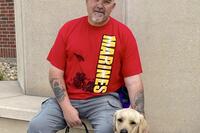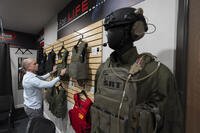ARLINGTON NATIONAL CEMETERY, Va. -- Holding back tears, Judi Boyer-Bouchard gently rubbed her fingers across her brother's name etched into a white marble headstone.
With two bundles of flowers in her other hand, she leaned over and placed one against the headstone. It was the first time she had seen the solemn marker for Sgt. 1st Class Alan Boyer, a 22-year-old Special Forces Soldier who disappeared in 1968 during a covert mission in Laos.
Decades later, Boyer's remains would be recovered by the Defense POW/MIA Accounting Agency, or DPAA, and later buried with full military honors here. Judi visited the cemetery in late June to mark the second anniversary of his funeral, or what she called his homecoming.
Five rows directly behind it, another headstone with a dark gold inscription -- signifying a Medal of Honor recipient --- drew her closer to the back of the cemetery's Section 28. There, she laid the rest of the flowers for 1st Lt. Doug Hagen, her brother's best friend who joined the Army on a sole mission to find his friend.
Boyer and Hagen, who was posthumously awarded the medal for his actions in the Vietnam War, were inseparable after they first met in high school in Decatur, Illinois.
Both were outgoing and leaders of their peers. In their senior year, Doug served as the class president and Boyer as the vice president.
"So brave, so smart, so much potential," she said. "But, both of them, doing what they wanted to do to make the world a better place. It's a miracle that Alan is by Doug today."
Since 1973, the remains of more than 1,000 Americans who went missing in the Vietnam War have been recovered, identified and returned to their families. Just under 1,600 are still unaccounted for from the war.
Those who have yet to be found are all part of DPAA's enduring mission, which began during the war and has since expanded around the world in search of Americans from past conflicts since World War II.
Each year, Soldiers and, on occasion, Army veterans participate in the dozens of recovery and investigation missions conducted by the agency's joint teams.
"We are still inherently fulfilling our promise made that when we send a service member off to war, that should they become missing, that it's our responsibility as a nation to bring them back home," said Kelly McKeague, director of DPAA.
CLOSE FRIENDS
Once Hagen heard Boyer had gone missing during his secretive mission, which was to install a wiretap along the Ho Chi Minh trail in Laos, he left college and signed up for the Army.
Judi later learned Hagen had joined in hopes of discovering what had happened to her brother.
While in, Hagen was able to get assigned to the same unit as Boyer, called the Military Assistance Command, Vietnam Studies and Observations Group, or MACV-SOG. The special operations unit conducted unconventional warfare missions behind enemy lines.
At the time, Judi was a 19-year-old college student struggling with the recent news of her brother. Years of frustration followed, she said, due to the lack of details surrounding his disappearance.
"You can't really explain what that loss is like. That not knowing what happened," she said. "Did they die that day, were they taken prisoner, did they live for several years?"
Hagen went on to deploy to South Vietnam, where he served as the team leader of a reconnaissance team. During that time, the unit was no longer allowed to execute missions in Laos.
In the early morning of Aug. 7, 1971, his team came under a fierce enemy attack while on a mission in northern South Vietnam near the former U.S. Marine Corps base at Khe Sanh.
Vastly outnumbered, the 25-year-old officer led his small team's defense and repeatedly exposed himself to enemy fire, according to his Medal of Honor award citation.
After he witnessed an enemy rocket hit a nearby bunker and then be overrun by the enemy, Hagen moved toward it to help his team members. In his desperate attempt to save others, he was fatally wounded.
Hagen's remains were subsequently returned to the U.S. and buried in Arlington. His close friend, however, was still unaccounted for.
MISSING IN ACTION
A few years before, during Boyer's mission, a helicopter had been called out to extract him, two other Special Forces Soldiers and seven Vietnamese soldiers from the Laotian jungle.
The enemy had them surrounded.
Unable to land, a rope ladder was dropped down from the helicopter. After the Vietnamese soldiers made it onto the ladder, Boyer, Sgt. 1st Class George Brown and Sgt. Charles Huston tried to get onto it when enemy gunfire cut the ladder, stranding all three men on the ground.
A few days afterward, a search and rescue team went out to the location but no sign of the men could be found.
When that information finally trickled down to the Boyer family years later, Judi still grasped at some hope that her brother may still be alive.
"To me, that indicated that they were probably taken prisoner because the enemy was right there," she said. "But again, we didn't know anything."
Several investigations and excavations followed, including one that discovered a tooth that led to the identification of Brown. The case for Huston is still open.
While Judi received regular updates from DPAA or its predecessor over the years, she said officials informed her no further pursuit would be made in her brother's case. She was told that witnesses to the incident, which occurred in the dense jungle, were no longer alive or could not be found.
Many recovery missions can take years to complete and are extremely difficult to conduct in Southeast Asia, where the acidity of the soil eats away at human bones. As the years pass, verifiable witness accounts are also harder to obtain.
"Time is our biggest enemy," McKeague said in a separate interview. "Witnesses are dying. Often times, our biggest attempt to be able to find an individual is to have a firsthand witness."
Understanding of the situation, the decision still left Judi devastated.
"I was very depressed," she said, "thinking I would truly never know."
COMING HOME
On March 7, 2016, the day before what would have been her brother's 70th birthday, Judi received a phone call.
When she picked up, a man with a deep voice began to speak on the other end. He informed her that he was an Army service casualty officer.
"My legs literally went out from under me," she recalled. "I said, 'You found Alan.' And he said, 'We did.' I could barely breathe."
As Boyer's only sibling, with both of her parents deceased, Judi became the main point of contact.
A few days later, DPAA officials and the casualty officer visited Judi at her home in Florida and provided a report on the forensics and investigations into her brother's case. The funeral service was also arranged.
She was told some Laotian people had found his remains, which eventually made it to the agency's lab. Through her DNA sample, she said, a piece of femur bone was linked to her brother.
"From that tiny piece of bone, they identified Alan," she said.
During the visit, Judi reconnected with Jack Kull, a policy officer at the agency who had befriended her and her family years before. Kull previously researched Boyer's team and had provided the Boyer family with details of its fateful mission.
He said Judi asked the former agency director, retired Army Lt. Gen. Michael Linnington, if there was a possibility that her brother could be buried close to his friend.
Soon after, a plot in Section 28 was reserved for Boyer.
"The stars were aligning," Kull said. "Al was going to be able to be buried near Doug. For Judi, I'm sure it was very bittersweet."
Before the funeral on June 22, 2016, she was invited to see her brother's casket. As she walked up to it, she noticed it was half open. She looked inside and admired the care given to her brother's uniform that proudly displayed his decorations and medals, including a Silver Star he had earned in his last mission.
"There was his Army uniform there with his remains tucked inside," she said. "That was truly an emotional and overwhelming moment. I had no idea that he would be buried in a uniform."
The casket was then put onto a caisson and wheeled out by horses to his gravesite, just 15 feet from his friend's final resting place. There, a customary ceremony with military precision took place with the playing of Taps, a gun salute and a folded U.S. flag presented to Judi. His engraved headstone would be placed at the site later.
A large contingent of family, friends, and Special Forces Soldiers and DPAA officials attended the ceremony to share in Judi's joy for the return of her brother.
She asked Kull to deliver the eulogy.
"It was a funeral, but in one sense it was a celebration," Kull said. "He was back home on American soil and he's going to be buried with heroes and literally feet from his high school buddy who went to Vietnam to look for him and was lost as well."
Judi called the service "a true homecoming." It was a homecoming that would not have happened, she said, if not for the dedication of those at the accounting agency.
"That was 48 years of hoping, grieving and looking for answers," she said. "The men and women of DPAA are dedicated to finding [those] answers. I am one of the very fortunate who have an answer now."















